Unit 12
The Galilean Ministry Ends
Unit 12
The Galilean Ministry Ends
Unit 12
The Galilean Ministry Ends
Chapter 01
The Disciples Function As Apostles
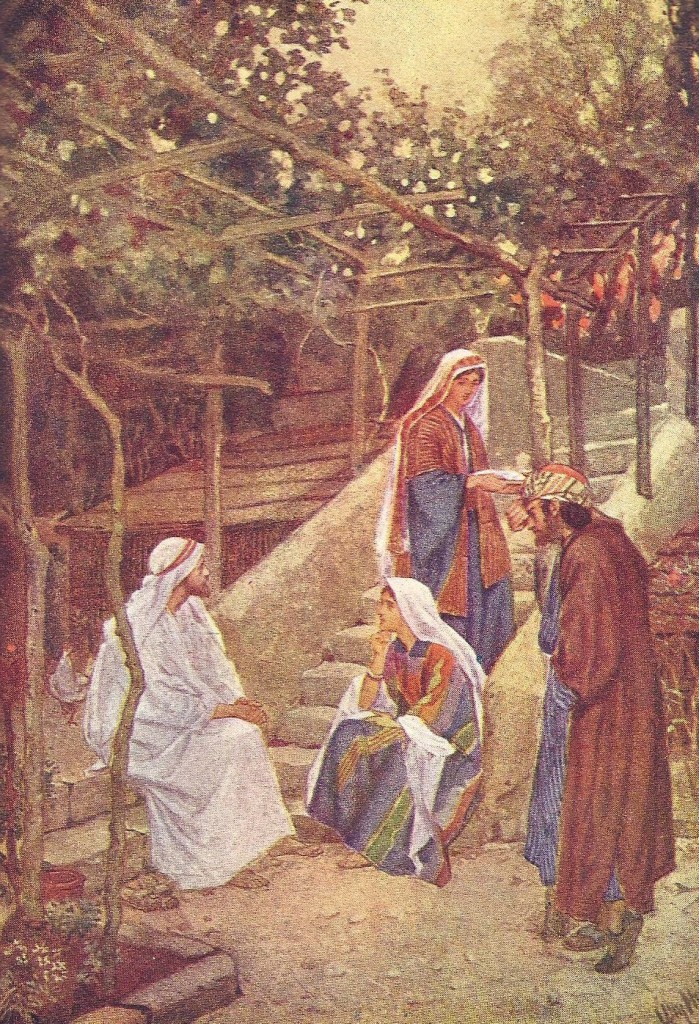
12.01.00.A. JESUS VISITS HIS FRIENDS IN BETHANY. Artwork by William Hole of the Royal Scottish Academy of Art, 1876. Jesus speaks with Mary, Martha, and Lazarus. His three friends lived in Bethany, a village on the southern slope of the Mount of Olives, a short walk from the old city of Jerusalem. (See Luke 10:38-42.)
12.01.01 Mt. 19:1-2; Lk. 9:51-56 (See also Mk. 10:1) Galilee to Samaria to Judea
GALILEAN MINISTRY ENDS
Mt. 1 When Jesus had finished this instruction, He departed from Galilee and went to the region of Judea across the Jordan. 2 Large crowds followed Him, and He healed them there.
Lk. 51 When the days were coming to a close for Him to be taken up, He determined to journey to Jerusalem. 52 He sent messengers ahead of Him, and on the way they entered a village of the Samaritans to make preparations for Him. 53 But they did not welcome Him, because He determined to journey to Jerusalem. 54 When the disciples James and John saw this, they said, “Lord, do You want us to call down fire from heaven to consume them?”
55 But He turned and rebuked them, 56 and they went to another village.
At this point the Galilean ministry ends, as Jesus predicted in Matthew 16:21. His time on earth was coming to a close and He began His final journey to Jerusalem.
“Region of Judea across the Jordan.” The gospels give interesting insights into geography and political areas. Today, Judea is not normally considered to be on the eastern side of the Jordan River, but Matthew and Mark clearly state this because the region of Perea was sometimes also known as the “region of Judea across the Jordan.”[1]
“Lord, do You want us to call down fire from heaven to consume them?” James and John certainly knew their Jewish history. The comment of calling fire down from heaven was reflective of Elijah who once called down fire from heaven and consumed 100 men and their two captains (2 Kgs. 1:9-16). So their thinking was quite logical: if someone like Elijah had the divine power and authority to call fire down from heaven, how much more could Jesus do? However, they had not realized that the Kingdom of Heaven was one of faith and obedience and cannot be spread by wrath and destruction. It must arise out of one’s heart with love and humility. It must rest upon a free and honest conviction, and it grows continuously in the love of Jesus.
The negative attitude of the disciples demonstrates that Luke’s gospel is authentic. Some critics have suggested that the gospels were created to embellish the life events of Jesus and His disciples. If that were the case, the gospel writers would not have included such negative comments as this one.
The reaction of the disciples was quite negative and typical of the sentiments most Jews had toward their Samaritan neighbors. Clearly the disciples wanted divine judgment – fire – to fall upon those who rejected them.[2] Most Samaritans, like so many Jews, had difficulty determining the identity of Jesus and, therefore, rejected Him as the messiah. But Jesus did not reject them; His compassion prevailed as He understood their difficulties. Later He healed ten lepers, one of whom was a Samaritan who returned to thank Him for the healing (Lk. 17:11-19). The disciples were willing to call fire from heaven to destroy them because of their hostile attitude, but the grace of God prevailed and, three years later, when the evangelist Philip began preaching, they were receptive (Acts 8:4-8).
[1]. Some ancient writers use the term “Judea” in the broadest sense. Examples are found in Pliny the Elder, Natural History, 5.15.70; Strabo, Geographia, 16.4.21; and Dio Sassius, Roman History, 37.15.2.
[2]. The term “fire” was frequently used by Old Testament prophets: Isa. 29:6; 66:15; Ezek. 38:22; Amos 1:4; 7:4; Zeph. 1:18; 3:8; Mal. 3:2; 4:1. The term is also found in numerous extra-biblical books such as Jubilees 9:15; 36:10 and in the Dead Sea Scrolls.
12.01.02 Lk. 10:1-16 (See also Mt. 11:20-24)
SEVENTY DISCIPLES SENT OUT
1 After this, the Lord appointed 70 others, and He sent them ahead of Him in pairs to every town and place where He Himself was about to go.
2 He told them: “The harvest is abundant, but the workers are few. Therefore, pray to the Lord of the harvest to send out workers into His harvest. 3 Now go; I’m sending you out like lambs among wolves. 4 Don’t carry a money-bag, traveling bag, or sandals; don’t greet anyone along the road. 5 Whatever house you enter, first say, ‘Peace to this household.’ 6 If a son of peace is there, your peace will rest on him; but if not, it will return to you. 7 Remain in the same house, eating and drinking what they offer, for the worker is worthy of his wages. Don’t be moving from house to house. 8 When you enter any town, and they welcome you, eat the things set before you. 9 Heal the sick who are there, and tell them, ‘The kingdom of God has come near you.’ 10 When you enter any town, and they don’t welcome you, go out into its streets and say, 11 ‘We are wiping off as a witness against you even the dust of your town that clings to our feet. Know this for certain: The kingdom of God has come near.’ 12 I tell you, on that day it will be more tolerable for Sodom than for that town.
13 “Woe to you, Chorazin! Woe to you, Bethsaida! For if the miracles that were done in you had been done in Tyre and Sidon, they would have repented long ago, sitting in sackcloth and ashes! 14 But it will be more tolerable for Tyre and Sidon at the judgment than for you. 15 And you, Capernaum, will you be exalted to heaven? No, you will go down to Hades! 16 Whoever listens to you listens to Me. Whoever rejects you rejects Me. And whoever rejects Me rejects the One who sent Me.”
“In pairs.” The concept of sending out disciples in pairs is a reflection upon “being yoked together” and “discipleship.” This creates a greater degree of self-confidence for those who work together. There are several interesting aspects to sending missionary teams in groups of two.
“The harvest is abundant.” The same words were spoken by Jesus to the disciples after the encounter with the Samaritan woman (Jn. 4). The compassion of Jesus for the lost never failed, regardless of the social and ethnic hostilities.
“Do not take a money-bag, traveling bag, or sandals.” It has been suggested that the reason Jesus gave these instructions was because He wanted to impress the urgency of the mission and saturate the land with His message. While that may have been true, there was a more important reason – one pertaining to identification. At this time itinerant stoic philosophers were going from village to village teaching their philosophies. They wore only blankets and left their hair grow which supposedly reflected divine philosophy and the achievement of the higher life of self-discipline and sanctity.[3] They not only attempted to gain converts, but also tried to live off the good graces of their hosts for as long as possible. Since they frequently begged for money or food, their money bags became known as “beggar bags,”[4] which happened to be identical to shepherd’s bags.[5] One Jewish scholar was a bit more polite in his description and called it an “alms-bag.”[6] Little wonder then, that Jesus did not want His disciples to have the appearance of the Stoics.
A point of interest might be that a wallet or scrips was a leather pouch that shepherds hung around their necks. Jewish men often wore them when traveling. The Roman satirist, Juvenal, (c. late 1st century A.D.) said that a wallet or basket was a characteristic of the Jews.
[To the] Jews who possess a basket and a truss of hay for all their furnishings.
Juvenal, Satire 3:14[7]
The difficulty of this passage lies in the fact that other passages indicate a worker is worthy of his hire (salary; v. 7) or that one should take a purse or bag. The explanation is that at this point in time, Jesus was not giving His disciples commandments for life, but instruction for particular situation.
As stated previously, the core issue is that it was difficult for the disciples to understand that to be a follower of Jesus they had to surrender themselves unconditionally to the will of God. Furthermore, they had to devote themselves unconditionally to the work of the Kingdom without any lingering connections to the world they left behind. In essence, His command for them not to take anything along was a physical picture of their future spiritual ministry. This was the same message given when Jesus said “let the dead bury the dead” (Lk. 9:59-62).
“If a son of peace is there.” This Hebraism refers to the head of the household – the father or husband, as well as his attitude. If he did not have a hospitable spirit, he was not a son of peace.
“The worker is worthy of his wages.” This phrase (Lk. 10:7) is significant for reasons of the historical development of theology, rather than history or culture. During the years A.D. 63-65, after the events of Acts 28, the Apostle Paul wrote his first letter to Timothy. In that letter, he combined this phrase with Deuteronomy 25:4 that reads “do not muzzle an ox while it is treading out grain.” The early church fathers followed the same principle for entertaining strangers. Itinerant preachers and prophets were not to ask for food or salary from their hosts, yet Jesus told His disciples they should willingly accept whatever is given to them. This passage from the Didache is therefore, insightful.
Let every apostle who comes to you be received as of the Lord. He shall stay one day, or, if need be, another day too. If he stays three days he is a false prophet. When the apostle leaves, let him receive nothing but enough bread to see him through until he finds lodging. If he asks for money he is a false prophet.
Do not treat any prophet who speaks in the Spirit, and do not judge him, for all sins will be forgiven, but this sin will not be forgiven. Not everyone who speaks in the Spirit is a prophet but only the one whose behavior is the Lord’s. So the false prophet and the prophet will be recognized by their behavior.
Didache 11:4-8[8]
You shall not listen to anyone who says in the Spirit, “Give me money or something,” but if he is asking that something be given for others who are in need, let no one judge him.
Didache 11:12
“Heal the sick.” Healing the sick and preaching the message of the Kingdom of God were constantly linked together. This was the mission of both Jesus and the disciples (Lk. 9:1-2, 11).
“On that day it will be more tolerable for Sodom.” The fiery destruction (Greek: phthora)[9] of that ancient city, as well as Gomorrah (Gen. 19:24-29), stood as a monumental warning for those who purposefully ignored God’s warning for repentance. Sodom and Gomorrah were two of five ancient cities that were well known for their sexual sins, especially the sin of homosexuality. They did not see Jesus perform miracles or hear His teachings, but could they have had this opportunity, they would have repented. Even though they did not hear specific laws of God, they should have obeyed common law concerning the matters of right and wrong. But they didn’t. So they will be punished, but their punishment will not be as great as for those who heard God’s laws and rejected them. This account shows that there are various degrees of punishment in the eternal hell.
However, the three villages along the northern edge of the Sea of Galilee did see and hear Jesus, and still rejected Him. When they did, Jesus pronounced judgment upon them by saying, “Woe to you, Chorizim . . . Bethsaida . . . Capernaum.” The phrase woe which in Greek is ouai and refers to both anger and sorrow is an expression of sorrowful pity.[10] The term is a dirge; a lament for the dead.[11] Furthermore, the word has a sympathetic tone, not an angry or furious tone.[12] His statement, “It will be more tolerable for Tyre and Sidon at the judgment than for you”, clearly illustrates that there are degrees of punishment in hell.
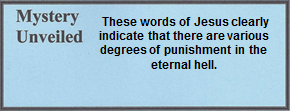
Clearly, Jesus was extremely upset with these three communities. As is typical throughout the Bible, God’s judgment is greatest against those who know right but choose to do wrong. These villages had witnessed multiple miracles and frequently heard His sermons, yet rejected His message. The wicked cities of Sidon and Tyre, on the other hand, did not hear the message of our Lord and would be judged in accordance with the little they knew – but judgment eventually came.[13] Those who sin horribly will suffer horribly. Apparently the good news of Jesus had reached those two cities, because people traveled from there to Galilee to hear Jesus preach (Lk. 6:17).
It is noteworthy to briefly examine “Tyre and Sidon” because these two Canaanite cities were significant in Israel’s history; history that was rather vivid to the audience of Jesus. They had three historical points to consider:
Therefore, when Jesus compared Chorizim, Bethsaida, and Capernaum as being worse than Sodom, Tyre, and Sidon, He most certainly burned everyone’s ear. Since He spoke firmly and with authority, His words made a powerful impact – one that stunned the religious leaders because they believed they were secure with God since they were “His chosen people.” But Jesus thought otherwise.
The changes in the social-political environment eventually led to the fulfillment of the prophetic curse. When the Zealots began the Second Revolt in A.D. 65, the Fifth Legion was brought in by the Emperor Titus to strengthen the Tenth Legion that was stationed in Damascus and had dominated the region for decades. Together they began a systematic devastation of the country, one village; one community after another. Chorizim and Bethsaida were both destroyed but Chorizim was rebuilt. It continued to grow to approximately 80 acres in size, but died with the Muslim conquest in 636. However, at the end of the fourth century, the church father Eusebius said that it was a destroyed village. This would appear to be in conflict with other historical sources, except that over the centuries many villages and cities that were destroyed were rebuilt only to be destroyed again. Nonetheless, the Muslim conquest ended village life in this community.
Capernaum was also destroyed by the Tenth Legion, but it too was rebuilt and continued to be a thriving community for both Christians and Jews. It was severely damaged in the earthquake of 363 (estimated 7.0 magnitude on the Richter scale) and was immediately rebuilt. Later, as a result of the Islamic invasion of 636 – six centuries after Jesus – a number of Arabs became residents of the prosperous village. By then many must have questioned the prophetic prediction by Jesus. However, His words were finally fulfilled on January 18, 749, when a destructive earthquake (estimated 6.6 magnitude on the Richter scale),[14] leveled the village and it was never occupied again. The words of Jesus for each village were fulfilled to the last detail in due time – His time. Bethsaida was destroyed by the Romans in A.D. 65, and Chorizim was destroyed centuries later in the 636 during the Islamic conquest.
Anyone in deep mourning wore a sackcloth garment, placed ashes or dirt[15] on the forehead, sat in the shade and wailed bitterly.[16] Ashes were sometimes from animal sacrifices, but regardless from the source, ashes, sackcloth, and sometimes torn clothing were signs of deep grief.[17] It was and still is common practice to let the emotions be expressed openly and loudly. Sackcloth was a rough and uncomfortable garment made from the hair of goats or camels, and at times worn next to the skin. Some scholars believe this coarse material was also used to make fishnets[18] as well as tents and grain sacks (Gen. 42:25; Josh 9:4). The Greek poet Homer wrote in his famous Iliad that when Achilles heard of the death of Patroclus, he grasped in both hands…
The ashes of the hearth, he showered them over his head and soiled with them his noble face.
Homer, The Iliad 18.23
Later in Homer’s story, another character by the name of Priam, mourned for the death of Hector and,
Sat with a cloak wrapped around him and dust strewn on his head and neck, which, when he rolled upon the earth, he had gathered with his hands.
Homer, The Iliad 24:162-65
Clearly, the custom of mourning in sackcloth and ashes was not unique to the Jews. On the other hand, stifling with ashes was a Persian mode of punishment as recorded in Maccabees 13:5-7. The Christian tradition of ashes applied to the believer’s forehead is rooted in the mourning tradition. Ash Wednesday is the name given to the first day of the Lent season – prior to Easter. The earliest Christian writings date to the 9th or 10th century Europe when Christians wore sackcloth and placed ashes on themselves as a sign of mourning and repentance of sins during the Lenten season.[19]
12.01.02.Q1 Did Jesus send out 70 or 72 disciples (Lk. 1:1-16 vs. Mt. 11:20-24; see also 12.01.02.Q3)?
There is an apparent discrepancy among biblical manuscripts concerning the number of disciples who were sent out on the short-term missionary journey. Among the translations, the King James Version reads 70, while others such as the New International Version of 1984, read 72. Why the numerical difference?
The answer is hidden in the third century (B.C.) Greek translation of the Hebrew Bible;[20] although not of any particular verse. At that time the Jewish people in Egypt were confronted with the challenges of a youthful generation that was speaking Greek and losing the Hebrew language. So, according to tradition or legend, the elders had 72 scholars translate the Hebrew Bible into Greek. In the course of time, the translation became known as the “Septuagint,’ meaning 70 and later represented by the Roman numeral symbol “LXX.” The number 72 had simply changed to 70 for conversational use; a type of verbal shorthand. Furthermore, in good Jewish tradition, the names of the translators were preserved as well.[21] The phrase did not have a literal meaning, but became a figure of speech. The same change may have occurred in regard to the number of missionaries who were sent out by Jesus. It is noteworthy that while the Sanhedrin has 70 members, the Council at Jamnia had 72 members, also known as elders.[22]
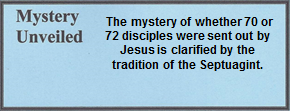
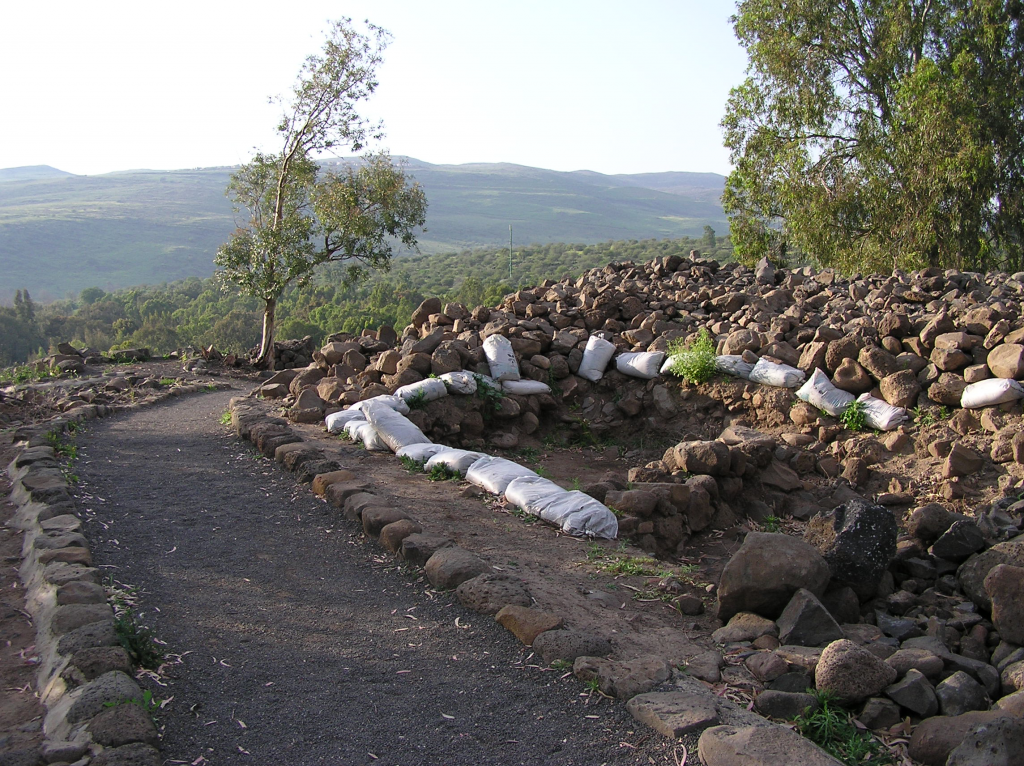
12.01.02.A. THE ARCHAEOLOGICAL SITE OF BETHSAIDA. A trail goes through the active archaeological site of what a growing number of archaeologists believe is Bethsaida (this writer disagrees). The sand bags around the excavation site reduce rain damage during the winter months when there is no archaeological activity. While the date of the founding of the village is unknown, archaeologists have uncovered the foundations of a city wall dated to the Assyrian conquest. The words of Jesus concerning its demise were fulfilled when the Romans destroyed it in during the First Revolt (A.D. 66-70). It was never rebuilt. Photographed in 2005 by the author.
12.01.02.Q2 What are the differences among the terms “Hell, Hades,” and “Gehenna?”[23]
Jesus spoke more of hell then He did of heaven which is why the words “hell, Hades,” and “Gehenna” are found numerous times within the gospels.[24] The New Testament provides a clear definition of hell as an eternal lake of fire (literally, the hell of fire),[25] but the terms “Hades” and “Gehenna” are somewhat ambiguous. Jesus said that the village of Capernaum would be sent down to Hades (Mt. 11:23; Lk. 10:15), an imagery that is synonymous with the Old Testament rendering of “Sheol” (e.g., Amos 9:2; Ps. 139:8).[26] The judgment that comes after time spent in Hades apparently will not be in Hades, but in another place called hell. In the parable of the rich man and Lazarus, the rich man is in torment in Hades, which implies that Hades is hell (Lk. 16:19-31). However, the section of Hades that is a place of torment in the earth[27] is certainly miserable and may seem like hell, but the lake of fire of hell is far worse.[28]
Hades has two distinct areas:
With two distinct areas in Hades, separated by a great divide, the rich man could communicate with Lazarus. This conversation would have been impossible if he were in hell and Lazarus in heaven. When Jesus died He went to Hades, as indicated by Peter in Acts (2:25-31), in which he quoted Psalm 16:8-11. The word “grave” means “Hades” and this narrative proves that Jesus not only was there, but also did not remain there.
8 I keep the Lord in mind always.
Because He is at my right hand,
I will not be shaken.
9 Therefore my heart is glad
and my spirit rejoices;
my body also rests securely.
10 For You will not abandon me to Sheol;
You will not allow Your Faithful One see decay.
11 You reveal the path of life to me; in Your presence is abundant joy;
in Your right hand are eternal pleasures.
Psalm 16:8-11
The eternal punishment, whether in the area reserved for the wicked in Hades or in hell, is often called “death” and, as such, is referred to four times in Revelation (1:18; 6:8; 20:13,14). In Revelation 20:14 John said that one day in the future, death and Hades would be thrown into the lake of fire (hell).
Also, the word “Gehenna” is used to describe a place of torment and eternal suffering. The name comes from the Valley of Hinnom, where supposedly, there was the city dump located in the modern Hinnom Valley along the southern or western side of the Old City of Jerusalem. The name “Gehenna” has three legendary sources, all from the Valley of Hinnom that is located along the southern and western sides of Jerusalem. The reasons for the name are as follows:
Obviously not all of these so-called sources of the name can be correct. The most popular seems to be the third one, and there are at least four reasons to argue against this interpretation.
The second suggestion is that pottery kilns were in the Hinnom Valley west and south of the city. This is also highly unlikely for the same reason. Along the southern side is where the priests and other aristocrats had their palace homes. They most certainly would not have wanted to be near burning trash heaps or pottery kilns. King David had his palace along the southern side. Furthermore, no archaeological evidence has been uncovered in the Hinnom Valley to support this theory, nor is it mentioned in any Jewish writings.
Finally, the primary reason the Hebrew name Ge-Hinnom is derived from the Valley of Hinnom,[29] that is where King Ahaz (2 Ch. 28:3; cf 2 Kg. 16:3) and King Manasseh (2 Ch. 33:6; cf 2 Kg. 21:6) sacrificed living babies to the pagan god, Molech (Jer. 32:35). This was the ultimate imagery – a picture of hell – of pain, agony, and death by ancient writers. Neither the Jewish nor the gospel writers could have conceived of anything worse than this era of incredible shame in Jewish history. Little wonder it is associated with those damned to hell by apocalyptic and New Testament writers.
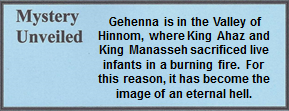
Hell is a real place that is given several descriptions such as being a fiery furnace (Mt. 13:42), a lake of fire (Rev. 19:20), a place of everlasting torment (2 Pet. 2:4), and a place of eternal fire (Jude 7). Jesus and the New Testament writers were dynamic on this issue and added that it is reserved for Satan and his angels as well as for those who reject Christ. It is that vast lake of fire where death will consume the wicked forever. These appear to be contradictory terms. The modern mind thinks of death as a distinctive ending point where life ceases to function. But in Hebraic thinking the continuous agony is so immense that it is called “death,” while the final breath never comes.[30]
The rejection imagery[31] and its association with eternal punishment with clearly expressed on both the Old[32] and New Testament, as well as in Jewish literature.[33] Eternal punishment is evident in Matthew 5:22 and 18:9 and Mark 9:43-44 say hell as a place of unquenchable fire, as does Matthew 25:41. The phrase “weeping and gnashing of teeth” occurs seven times in the gospels.[34] The phrase “outer darkness” occurs three times (Mt. 8:12; 22:13, and 25:30) and is also referred to in 1 Enoch 102:8. Inter-Testament literature frequently mentions hell and fire together. The “casting out” judgment imagery of Matthew 22:13 is also found in 1 Enoch 10:4. Likewise the term “furnace of fire” is found in the Parables of the Wheat and Tares (Mt. 13:42) and the Parable of the Dragnet (Mt. 13:50). This imagery is not only for those who reject Christ, but is also reserved for those who claim to be followers of Jesus, but have never truly committed themselves to His lordship.
The Greek word abyssos has been translated to mean “bottomless” and is found in the LXX translation of Genesis 1:2. It also occurs six times in John’s Revelation (9:1-2, 11; 11:7; 17:8; 20:1, 3) where it is described as the place of endless torment and punishment. But this term was also used to refer to the bottom of the Sea of Galilee where the Gentiles believed the demons lived. That was a cultural interpretation[35] and not a theological one.[36]
The term sheol has on occasion been incorrectly translated as hell. The Old Testament concept of sheol is not a place of torment, but a land of shades, a shadowy and joyless, ghostly place. The New Testament understanding of heaven and hell is not related to sheol, and there is hardly any concept of eternal life in the Hebrew Bible.[37]
12.01.02.Q3 Did the 70 or 72 disciples go to Jewish or Gentile homes (Lk. 1:1-16. Mt. 11:20-24; see 12.01.02.Q1)?
Some scholars have said that the 72 (or 70) went to Jewish communities, while others believe they went to the hated Samaritans and Greeks in the Decapolis cities. If they went to non-Jewish homes, they would have eaten non-kosher meals with their hosts. That alone would have been a major theological adjustment at this time. The rules concerning kosher foods do not appear to relax until the book of Acts. So therefore, it is the opinion of this writer that they probably went to Jewish homes, especially since their journey appears to have been several days in length. And if they went to Gentile communities, they probably stayed in Jewish homes there.
[1]. Deut. 17:6; 19:15; Gilbrant, “Luke” 317.
[2]. See also comment on Mt. 18:19-20.
[3]. Hatch, The Influence of Greek Ideas and Usages. 166.
[4]. Angel, “Bag, Box.” 1:142-43.
[5]. See Josephus, Antiquities 8.7.3 (185).
[6]. Vine, “Wallet.” Vine’s Complete Expository Dictionary. 2:665.
[7]. http://ancienthistory.about.com/gi/o.htm?zi=1/XJ&zTi=1&sdn=ancienthistory&cdn=education&tm=131&f=00&su=p284.13.342.ip_&tt=2&bt=0&bts=0&zu=http%3A//www.fordham.edu/halsall/ancient/juv-sat3lat.html Retrieved June 5, 2012. Geikie, The Life and Words. 2:631. See also Juvenal, Satire 6:542.
[8]. The Didache is a book on church order that was written within a century of the life of Jesus. For more information, see 02.02.08.
[9]. Barclay, “Destruction.” Jesus. 264.
[10]. Lang, Know the Words of Jesus. 182.
[11]. Smith, Augsburg Commentary on the New Testament: Matthew. 157, 274.
[12]. Barclay, “Matthew.” 2:12-13.
[13]. Isa. 23; Jer. 25:22; 47:4; Ezek. 26:3-7; 28:12-22.
[14]. http://israel-tourguide.info/2011/01/10/earthquakes-history-archaeology/. See also http://geology.geoscienceworld.org/content/31/8/665.abstract and http://en.wikipedia.org/wiki/749_Galilee_earthquake Retrieved on August 25, 2014.
[15]. See 1 Sam. 4:12; 2 Sam 1:2; 13:19; Job 2:12; Ezek. 17:30; Rev. 18:19 and Judith 4:114-15.
[16]. Esth. 4:1; 1 Kgs. 21:27; See also 2 Kgs. 6:30; Job 16:15.
[17]. Vine, “Ashes.” Vine’s Complete Expository Dictionary. 2:39.
[18]. Vincent, Word Studies in the New Testament. 1:351.
[19]. http://www.orlutheran.com/html/ash.html Retrieved December 7, 2013.
[20]. See Septuagint in 02.02.25.
[21]. B. S. J. Isserlin of the University of Leeds has an article titled The Names of the 72 Translators of the Septuagint based upon the Pseudepigraphic Letter by Aristeas (47-50) to his brother Philocrates written in the 2nd century B.C. It was later repeated by Philo of Alexandria as well as Josephus in Antiquities 12.2.7 (57). The article by Isserlin is available at https://www.jtsa.edu/Documents/pagedocs/JANES/1973%205/Isserlin5.pdf Retrieved June 29, 2015.
[22]. Lightfoot, A Commentary on the New Testament from the Talmud and Hebraica. 3:94; For more information on the Septuagint, see 02.02.25.
[23]. See also 08.01.05.
[24]. For “Gehenna,” see 02.03.09; 08.01.05 and 10.01.06. For “Hades,” see 08.01.05; 09.01.05; 10.01.29; 12.01.02; 12.03.09 and 18.01.01. For “Hell,” see 08.01.05; 09.02.04; 10.01.29; 12.01.02; 12.03.09; 13.05.02; 15.03.12; 16.01.18; 17.02.02; 18.01.01 and 18.02.01.
[25]. Vincent, Word Studies in the New Testament. 1:40.
[26]. Wuest, Wuest’s Word Studies. 46.
[27]. Mt. 11:23; Lk. 10:15; Bietenhard, “Hell, Abyss, Hades, Gehenna, Lower Regions.” 2:07.
[28]. The topics of Gehenna, Hades, and Hell have been the subject of discussions for many theologians, and there are no shortages of interpretations. However, all agree that it is not a place where one wants to be for a moment, much less forever.
[29]. Lang, Know the Words of Jesus. 41; Miethe, The Compact Dictionary of Doctrinal Words. 97.
[30]. Bass, “Hell.” 6:809-10; Scharen, “Gehenna in the Synopics.” 324-337.
[31]. For further study, see Pagenkemper, “Rejection Imagery in the Synoptic Parables.” 179-198.
[32]. Old Testament prophets who spoke of a final judgment were Isaiah (17:11) and Joel (3:13). Two other prophets who made similar statements concerning Babylon and Ephraim were Jeremiah (51:33) and Hosea (6:11).
[33]. For example, see 1 Enoch 1:18, 23-24, 38, 71-72, 81, 84, 88; 2 Enoch 1:118-19, 188; Sibyliline Oracles 1:323-24, 333, 385, 409, 469, 471.
[34]. Mt. 8:12; 13:42, 50; 22:13; 24:51; 25:30, and Lk. 13:28.
[35]. In the Inter-Testamental book of Enoch, the writer said that the abyss was the prison for fallen spirits/angels (10:4ff; 18:11ff). The writer of Jubilees said likewise in 5:6ff.
[36]. Bietenhard, “Hell, Abyss, Hades, Gehenna, Lower Regions.” 2:205.
[37]. Barclay, “John.” 2:91-92.
12.01.03 Lk. 10:17-24
SEVENTY DISCIPLES RETURN
17 The Seventy returned with joy, saying, “Lord, even the demons submit to us in Your name.”
18 He said to them, “I watched Satan fall from heaven like a lightning flash. 19 Look, I have given you the authority to trample on snakes and scorpions and over all the power of the enemy; nothing will ever harm you. 20 However, don’t rejoice that the spirits submit to you, but rejoice that your names are written in heaven.”
21 In that same hour He rejoiced in the Holy Spirit and said, “I praise You, Father, Lord of heaven and earth, because You have hidden these things from the wise and the learned and have revealed them to infants. Yes, Father, because this was Your good pleasure. 22 All things have been entrusted to Me by My Father. No one knows who the Son is except the Father, and who the Father is except the Son, and anyone to whom the Son desires to reveal Him.”
23 Then turning to His disciples He said privately, “The eyes that see the things you see are blessed! 24 For I tell you that many prophets and kings wanted to see the things you see yet didn’t see them; to hear the things you hear yet didn’t hear them.”
This is an interesting contrast where these 72 disciples performed incredible miracles, but the twelve closest disciples could not bring healing to an epileptic boy (Lk. 9:37-43).
The doctrine of “binding and loosing” has the traditional meaning of “forbidding and permitting.”[2] The word binding (Gk. deo) is used in 1 Corinthians 7:29 in reference to marriage, while loosing (Gk. lyo) is used when laws are relaxed (Mt. 5:19) and sins are forgiven (Rev. 1:5).[3] Nonetheless, the terms appear not to have been used in the performance of miracles of casting out demons. Jesus may have expanded the traditional parameters of the definition. His divine power convinced many to believe His message of the Kingdom of God. Now that power was transferred to His disciples, more people would hear the message and believe in His name. Evidently, the early church continued the practice, as recorded by Origen in his reply to Celsus:
By their prayers Christians are of more service to the realm than if they had fought for it in the legions, for by their petitions they vanquished all demons who stir up war and disturb the peace.
Origen, Against Celsus 1:24[4]
“I watched Satan fall.” Jesus again attests to His eternal existence. However, now He also declares His superior power and authority over Satan. Jesus was in heaven when the evil one was thrown out by His authority. There are three possibilities to understanding this statement, and all three are correct:
12 Shining morning star, how you have fallen from the heavens!
You destroyer of nations, you have been cut down to the ground.
Isaiah 14:12
So the great dragon was thrown out — the ancient serpent, who is called the Devil and Satan, the one who deceives the whole world, He was thrown to earth, and his angels with him.
Revelation 12:9
Jesus, speaking in past-tense language, was looking toward the future, after His thousand year reign to the ultimate defeat of Satan as recorded by John.
7 When the 1,000 years are completed, Satan will be released from his prison 8 and will go out to deceive the nations at the four corners of the earth, Gog and Magog, to gather them for battle. Their number is like the sand of the sea. 9 They came up over the surface of the earth and surrounded the encampment of the saints, the beloved city. Then fire came down from heaven and consumed them. 10 The Devil who deceived them was thrown into the lake of fire and sulfur where the beast and the false prophet are, and they will be tormented day and night forever and ever.
Revelation 20:7-10
“Snakes and scorpions and over all the power of the enemy.” There is a debate concerning the phrase “snakes and scorpions.”
“Rejoice that your names are written in heaven.” In ancient times, the genealogical records of the Jewish people were kept in the temple. Roman cities had the names of citizens recorded. Likewise, the epistles note that the names of true believers are written in heaven[5] and Revelation 20 refers to the heavenly “Book of Life” that has the names of all true believers. Jesus said that it is far more important that one’s name be written in the right book than to have the ability to perform signs and wonders and lose his life.
Finally, some scholars believe that Luke 10:21-22 (cf. Mt. 11:25) was incorporated into an early church hymn. It is believed that a number of sayings by the apostles were remembered because they were put to music.[6]
[1]. For further study on binding and loosening see 08.04.07.Q1 “What verbal formulas did exorcists use when casting out demons?” the account of the demoniac whom Jesus cleansed in 08.06.03; the phrase “Bound in heaven . . . loosed in heaven,” in 11.02.08; the phrase “Bind on earth … loose on earth” in 10.01.29; and the phrase “Lord, even the demons submit to us in Your name,” in 12.01.03. An excellent resource for further study was written by Foster and King, Binding and Loosening: Exercising Authority over Dark Powers. See also Lightfoot, A Commentary on the New Testament from the Talmud and Hebraica. 1:254-55, and Jeremias, Jerusalem in the Time of Jesus. 236.
[2]. A wide range of meanings to the term “binding and loosing” is found in Judg. 16:6, 13; Job 38:31; Isa. 22:21, 66:1; Ezek. 20:37; Tobit 3:13, 7:11; 1 Enoch 6:4; Mt. 22:23, 23:4; Lk. 8:29; Acts 20:22; 22:4 Rom. 7:1; and 1 Cor. 7:39. See also Charlesworth, The Old Testament Pseudepigrapha. 1:795. See aslo Richard Hiers, “’Binding’ and ‘Loosing’: The Matthean Authorizations.” Journal of Biblical Literature. 104:2 (June, 1985). 236-37.
[3]. Tongue, “Binding and Losing.” 1:199.
[4]. Thomas, The Golden Treasury of Patristic Quotations: From 50 – 750 A.D. 202.
[5]. Philip. 4:3; Heb. 12:23.
[6]. A number of early Christian hymns are embedded in the New Testament. The best known are 1) the Magnificat (Lk. 1:46-55); 2) the Nunc Dimittis (Lk. 2:29-32); 3) Eph. 5:14 is considered to be either a baptismal hymn or a hymn to the unconverted; 4) 1 Tim. 3:16 is an early church creed that was sung, and 5) 2 Tim. 2:11 ff. is thought to be a fragment of an Eucharistic hymn. Philippians 2:6-11 was known as the Christ Hymn. Other verses that were incorporated into songs are. Acts 4:24-28, Col. 1:15 ff., Lk. 10:21-22 = Mt. 11:25 ff., and Jn. 1:1-5, 9-13. See Mould, Essentials of Bible History. 527.
12.01.04 Mt. 11:28-30
REST FOR THE WEARY
28 Come to me,
all of you who are weary and burdened,
and I will give you rest.
29 All of you,
take up My yoke and learn from Me,
because I am gentle and humble in heart,
and you will find rest for yourselves. 30 For My yoke is easy and My burden is light.
This imagery of a yoke was not new to His listeners. The Oral Law referred to one who would pick up the yoke of the Mosaic Law and He would be delivered from the oppressive yoke of worldly cares. The phrase “worldly care” (below) referred to the encroaching Greek culture. The rabbinic literature reads as follows:
Rabbi Nehunya ben Ha-Kanah said:
“He that takes upon himself the yoke of the Law,
from him shall be taken away the yoke of the kingdom
(meaning the troubles suffered at the hands of those in political power)
and the yoke of worldly care.
But he that throws off the yoke of the Law,
upon him shall be laid the yoke of the kingdom
and the yoke of worldly care.”
Mishnah, Aboth 3.5
There is an astounding parallel to the words of Jesus that predate Him by more than a century from the book of Ben Sirach. The Inter-Testament writer said this:
Draw near to me, you unlearned, and lodge in the house of study. Why are you slow, and what do you say about these things, your souls being very thirsty? I opened my mouth and said, “Buy her [wisdom] for yourselves without money. Put your neck under [her] yoke, and let your soul receive instruction. She is to be found nearby. See with your eyes how, with only a little labor, I have gotten much rest.
Ben Sirach 51:23-27[1]
These two quotations demonstrate again how the message of righteousness that had been preached by so many righteous rabbis, was foundational to the kingdom of God message presented by Jesus.
“Take up My yoke and learn from Me.” The traditional yoke was a device placed on the necks of two draft animals to cause them to work as a team and allow them to pull a farm implement such as a plow. Using this imagery, Jesus said His yoke is easy, meaning that whoever would pick up the “yoke,” would be yoked to Him. In ancient times, yokes were custom made for each pair of animals, since one beast was the stronger than the other. To be yoked with Jesus means to work with Him for a specific ministry. He is the stronger member of the team, and hence, the burden is light.
It also had a reference to the rabbi’s teaching, philosophy and interpretation of Scripture.[2] Jesus is referred to as a teacher forty-one times, indicating that as a teacher He would help those who would follow Him. Learning His lessons would not be difficult, but living them could be more challenging.
So why did Jesus say that His yoke was easy or light? The Greek word for easy is chrestos, which means well fitting.[3] It was certainly a term with which Jesus was well acquainted, since as a carpenter, he had made so many of them (yokes). In comparison to the rigorous requirements demanded by leading Pharisees and their Oral Law, the requirements of Jesus were relatively easy to obey.
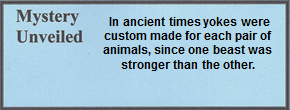
“My yoke is easy.” For nearly three centuries after Jesus, Christians were tortured and martyred which, amazingly, was a purification element and helped the church to grow and expand into many nations. Many Christians today, especially those living in persecuting countries, understand that all too well. To follow Christ; to live a life that honors God and upholds biblical principles, is not always easy in the modern sense of the word. The issue of persecution was never hidden in the discussions of Jesus, although it is seldom the subject of sermons today. Concerning the biblical phrase, the word easy would be better translated wholesome, serviceable, and kindly.[4] The hidden message of being “yoked with Jesus” is that He is the stronger one and the believer is the weaker one. In that sense, being yoked with Jesus is serviceable and kind.
[1]. Cited by Bivin, bracketed inserts by Bivin, New Light on the Difficult Words of Jesus, 23-24.
[2]. http://www.jewishrootsofchristianity.org/jewishroots/discipleship-in-jesus-day.pdf Retrieved January 12, 2012.
[3]. Barclay, “Matthew.” 2:17.
[4]. Vincent, Word Studies in the New Testament. 1:70.
12.01.05 Lk. 10:25-37
PARABLE OF THE GOOD SAMARITAN
25 Just then an expert in the law stood up to test Him, saying, “Teacher, what must I do to inherit eternal life?”
26 “What is written in the law?” He asked him. “How do you read it?”
27 He answered: Love the Lord your God with all your heart, with all your soul, with all your strength, and with all your mind (Deut. 6:5); and your neighbor as yourself (Lev. 19:18).
28 “You’ve answered correctly,” He told him. “Do this and you will live.”
29 But wanting to justify himself, he asked Jesus, “And who is my neighbor?”
30 Jesus took up the question and said:
A “A man was going down from Jerusalem to Jericho and fell into the hands of robbers.
They stripped him, beat him up,
and fled, leaving him half dead.
B 31 A priest happened to be going down that road.
When he saw him,
he passed by on the other side.
C 32 In the same way, a Levite, when he arrived at the place
and saw him,
passed by on the other side.
D 33 But a Samaritan on his journey came up to him, and
when he saw the man,
he had compassion.
C’ 34 He went over to him
and bandaged his wounds,
pouring on oil and wine.
B’ Then he put the him on his own animal,
brought him to an inn
and took care of him.
A’ 35 The next day he took out two denarii and gave them to the innkeeper, and said. ‘Take care of him. When I come back I’ll reimburse you for whatever extra you spend.’
36 “Which of these three do you think proved to be a neighbor to the man who fell into the hands of the robbers?”
37 “The one who showed mercy to him,” he said. Then Jesus told him, “Go and do the same.”
Literary Style.[1] The poem is written in the style of step parallelism in which each stanza has three lines. From stanzas A to C’, the first line is one that describes an action by someone. This action is a “come” action. The middle line of every stanza of the parable is a “do” action. The last lines of the first five stanzas are a “go” action of some sort. The Samaritan who demonstrated compassion did care for the injured traveler, as expressed by the last line of stanzas C’ to A’ which are also “do” actions in that he took care of the injured.
Cast of Characters
The Traveler = The injured victim of robbery who was lying on the side of the road.
The Priest = A servant of man and God, who lived and functioned with numerous restrictions and responsibilities.
The Levite = An assistant to the priest in the temple who had fewer life restrictions and responsibilities.
The Samaritan = A member of an ethnic group hated by the Jewish people, but who truly demonstrated the love of God.
The story takes on realism because many priests and Levites lived in Jericho where a large synagogue was constructed by the Hasmoneans in the previous century. In fact, it has been estimated that about half the courses that served in Jerusalem (see 04.03.01) lived in Jericho,[2] meaning they would have traveled the road of the Good Samaritan parable. The Jericho to Jerusalem road is a winding, narrow road that was at times cut into the side of a mountain with an upward cliff on the south side and a sheer precipice on the north side with a drop of hundreds of feet down into a wadi below. Along this road, Zealots robbed traveling pilgrims and Romans who had limited opportunities to escape.
Jesus put the setting of the parable along a five mile section of the 16 mile road that for centuries had a reputation as being extremely dangerous[3] – known as “the Bloody Way.”[4] For reasons of safety, men frequently carried short concealed swords and families traveled in groups or camel caravans, such as Mary and Joseph did on their journey to and from Egypt, and later when they and Jesus (aged twelve) went to the temple.[5] Those who traveled to and from Jerusalem for religious observances traveled in festival caravans.[6] At the time when Herod the Great was given rulership of the land, the whole region was filled with highway robberies, some of which continued throughout Roman occupation.[7]
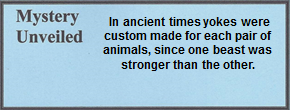
Traveling for the Galileans was always a challenge. If they went through Samaria they were in danger of attack by the Samaritans; if they went via Jericho they were in danger of robbers. Josephus said that the Samaritans killed a “great many” Galileans who were in route to Jerusalem, which clearly reflected the danger.[8] Galileans, therefore, frequently traveled south by taking a road located on the eastern side of the Jordan River in Perea. When they arrived near Jericho, they turned westward, crossed the river, went to the rebuilt city of Jericho and rested.[9] From there they walked up the Jericho-Jerusalem Road through the narrow Wadi Kelt canyon walls and on to the Holy City.
To insure maximum safety, people traveled in groups with the following formation:
Country roads were always dangerous, which is why the Essenes never carried anything but a small sword. One would ever walk alone on this country road unless it was absolutely necessary. In fact, Josephus recorded that Judea was full of robberies;[10] therefore, this parable of Jesus had a dynamic reality to the listeners. While the road was open for tourists during the 1990s, as of this writing it is closed due to Palestinian bandits and terrorists.
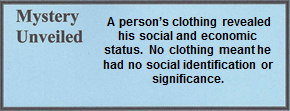
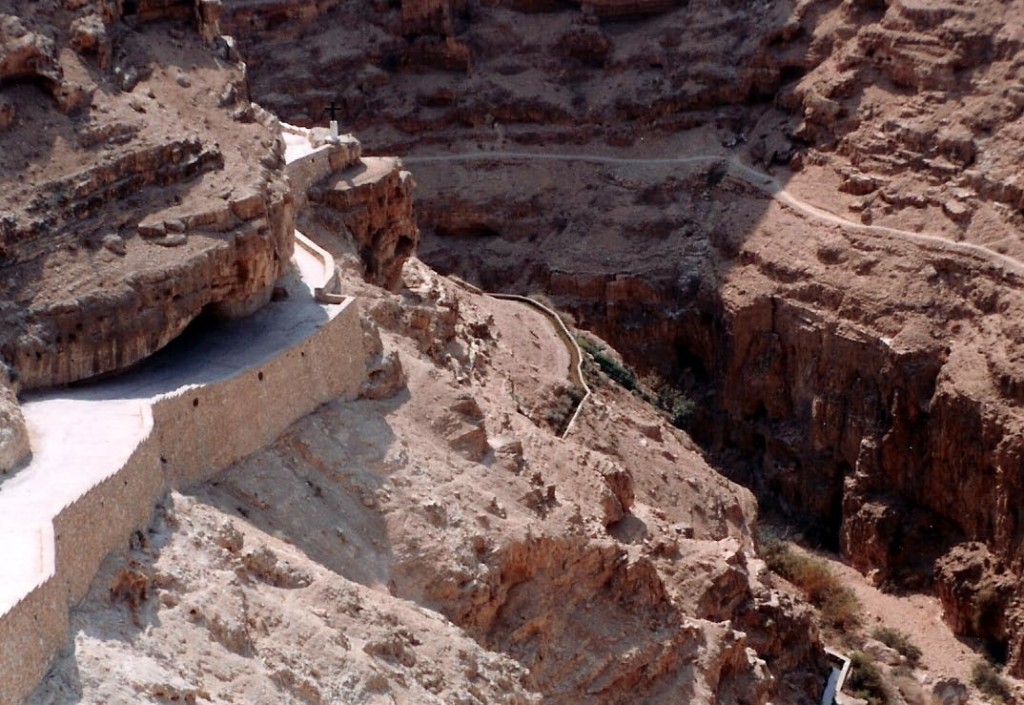
12.01.05.A. THE DANGEROUS CLIFFS OF THE WADI KELT ALONG THE JERICHO-JERUSALEM ROAD. Shown is a side road to the 16 mile road, known as the Way of Blood,[11] is the setting for the Parable of the Good Samaritan, was a treacherous road cut into steep hillsides and mountains. People traveled in groups for protection from would-be robbers even though Roman soldiers patrolled the area to insure safety. Photograph by the author.
In this parable, an expert in the law – presumably a scribe – stood up to challenge Jesus. Even though his intention was a verbal confrontation, it was with respect. Teachers sat when teaching and students stood in respect to their teacher, especially when speaking. In true Jewish style, the gentleman stood to address Rabbi Jesus about the requirements needed to inherit eternal life. The answer is not a check list of things to do, such as the Ten Commandments, or a philosophical concept, as might be expected by the lawyer (“Scribe”) or by modern Westerners.
In response, Jesus who was seated tells a story of a traveler who was robbed, beaten, and left for dead along the only road from Jericho to Jerusalem. Technically, the physician Luke said he was half dead (Gk. hemithanes 2253), and obviously in grave condition. Jesus then identifies three men who walked by and what they did. The Samaritans were highly despised for reasons previously discussed. The priest and Levite were men of a high religious order; men who were to reflect the character and compassion of God, but chose not to offer assistance. The priests were descendants of Aaron, while the Levites were descendants of Levi. Each group had a different, but important function in the temple. The Priests could take part in the sacrifices and enter the inner sanctuary, while the Levites insured protection of the temple grounds and sang in the choirs.[12] Both the Levite and priest were concerned about becoming defiled if they touched a man who was dead. They did not even care enough to see if he was still alive and possibly help him, only that they might become defiled. The Samaritan, on the other hand, had the same restrictions according to the Samaritan Torah, but he was not only willing to take the chance and become defiled, but then he helped the wounded man and paid for his medical attention.
The lifestyles of the priests were highly restricted by the Mosaic Law. For example, if a priest touched a corpse he would be defiled, but the law did not apply to Levites (even though they were concerned about defilement). This was one of 613 commands in the Law of Moses (248 positive, 365 negative).[13] However, the Law also stated that priests and Levites were required to offer assistance to save a life. But in the story, they chose not to. Then the Samaritan came who offered assistance to the stranger. He obviously was the good neighbor who demonstrated obedience to the Mosaic Law where the priests and Levites failed.[14]
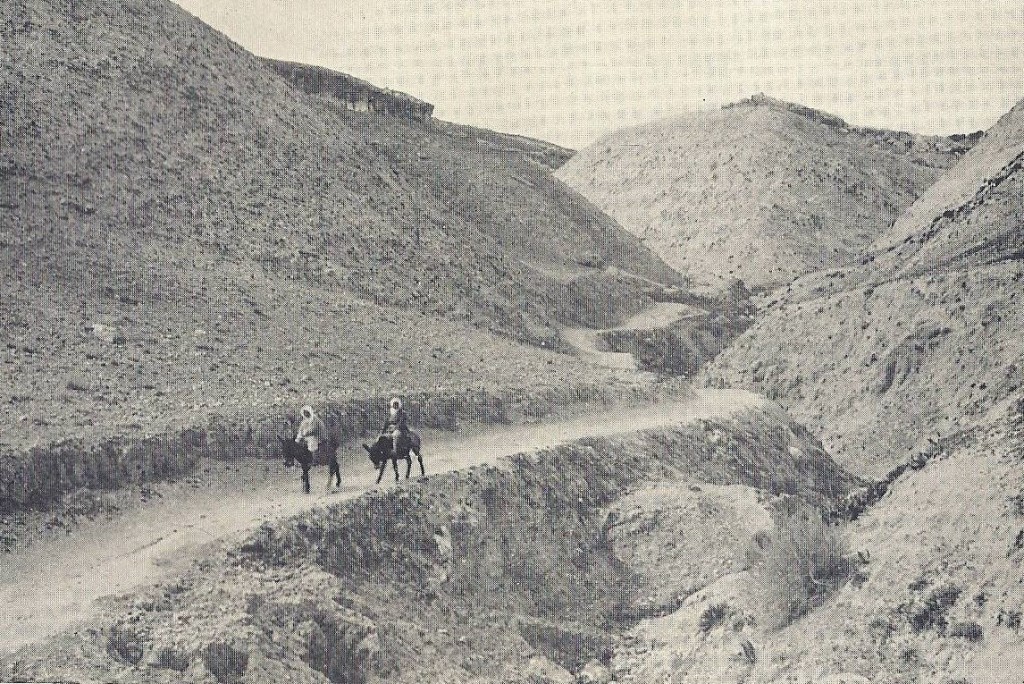
12.01.05.B. THE UPPER SECTION OF THE JERICHO-JERUSALEM ROAD. The famous road is shown as it was in the 1920s. Throughout history it was a passageway notorious for high risk travelers who traveled alone or in small groups. Photograph by Mary Morton / Public Domain.
“Strength.” The Greek word is Dunamis (1411), and is often ascribed to the power of God (Rev. 5:12, 7:12). Clearly the love to be expressed by believers is to the full human potential, and then more.[15]
“Neighbor.” The Greek term plesion (4139) refers to a specific person, whereas the plural form (geiton, 1069) in the New Testament refers to anyone living in the same land.[16] Jesus obviously rejected the popular opinion that a neighbor was only a fellow Jew. In the first century, people maintained strong ethnic ties and were identifiable by the style of clothing they wore. Clothes were a type of identity badge that displayed the economic status, tribal affiliation, social, and religious affiliation of a person. Back then as now, clothes, language, or accent were markers that distinguished “them from us.” [17] Over the years the religious leaders had redefined the word “neighbor” in the Mosaic command (Lev. 19:18) to mean those who wore the same clothes. The parable specifically stated the man who was robbed and injured was also without his clothes, meaning, he had no social identification and, evidently, could not communicate (Lk. 10:30).[18] So he was no one’s neighbor.
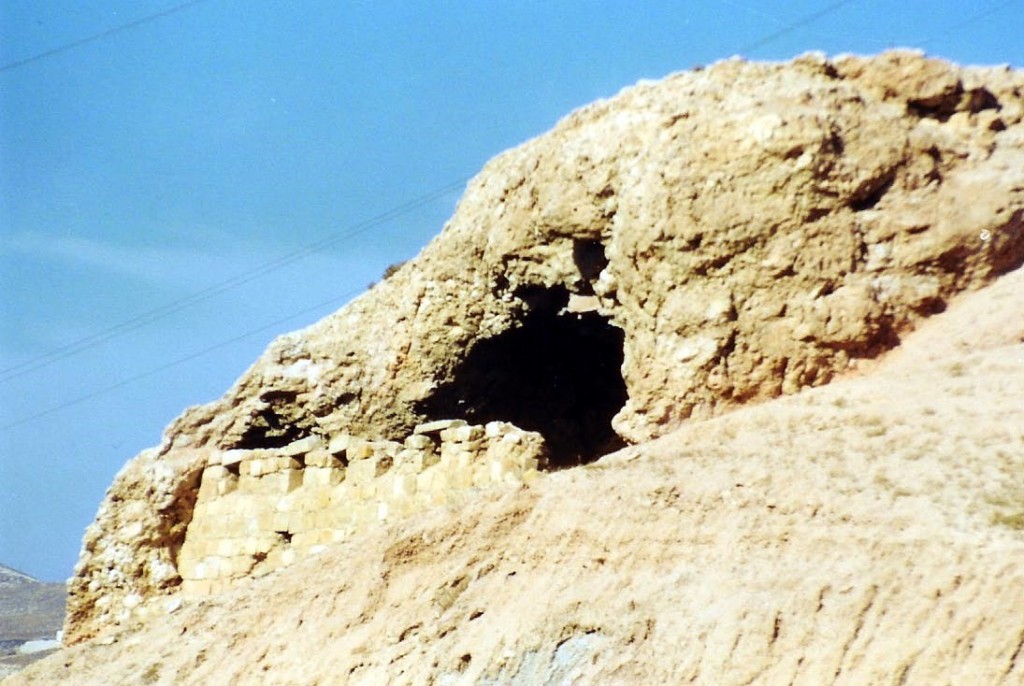
12.01.05.C. THE RUINS OF A TURKISH MILITARY OUTPOST ALONG THE JERICHO-JERUSALEM ROAD. This abandoned outpost, dated to the Ottoman Empire (1517-1917), was reflective of the centuries-old problem travelers had with robbers along the feared Jerusalem-Jericho Road. Soldiers stationed here protected travelers from robbers. It was constructed in front of a natural cave so the soldiers would be protected from the desert heat. Photograph by the author.
The Parable of the Good Samaritan (nowhere in the Bible is he called “good”) was given by Jesus to answer the question posed by an expert of the law: “And who is my neighbor?” The answer by Jesus was “Anyone who has a need.” To illustrate the question, “who is my neighbor?” Jesus used the parable because His listeners were aware of the traveling dangers associated with the road and, as such, it was the subject of other stories.
The Levite and priest were probably concerned about their own purity should the injured man die while in their care. They preferred the man to suffer death rather than take the chance of becoming “unclean.” The irony is that the Levites not only served in the temple, but they also acted as clergy throughout the land and were responsible for social welfare. If anyone should have taken care of the poor traveler, it should have been the Levite.
From the Mishnah is the following narrative that was probably their concern:
A high priest or a Nazarite may not contact uncleanness because of their (dead) kindred, but they may contract uncleanness because of a neglected corpse. If they were on a journey and found a neglected corpse, Rabbi Eliezer says: “The high priest may contract uncleanness but the Nazarite may not contract uncleanness.” But the sages say: “The Nazarite may contract uncleanness but the high priest may not contact uncleanness.” Rabbi Eliezer said to them: “Rather let the priest contract uncleanness for he needs not to bring an offering because of his uncleanness, and let not the Nazarite contract uncleanness for he must bring an offering because of his uncleanness.” They answered: “Rather let the Nazarite contract uncleanness, for his sanctity is not a lifelong sanctity, and let not the priest contract uncleanness, for his sanctity is a lifelong sanctity.”
Mishnah, Nazir 7.1
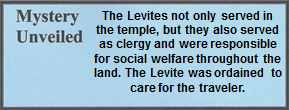
In a unique manner, Jesus answered the question, “And who is my neighbor?” from the point of cleanliness, since that was a major issue in first century Judaism. The parable intensified the popular rabbinic story and Jesus used it to demonstrate that to show love, compassion, and mercy to someone in need was far more important than the traditional “cleanliness.”
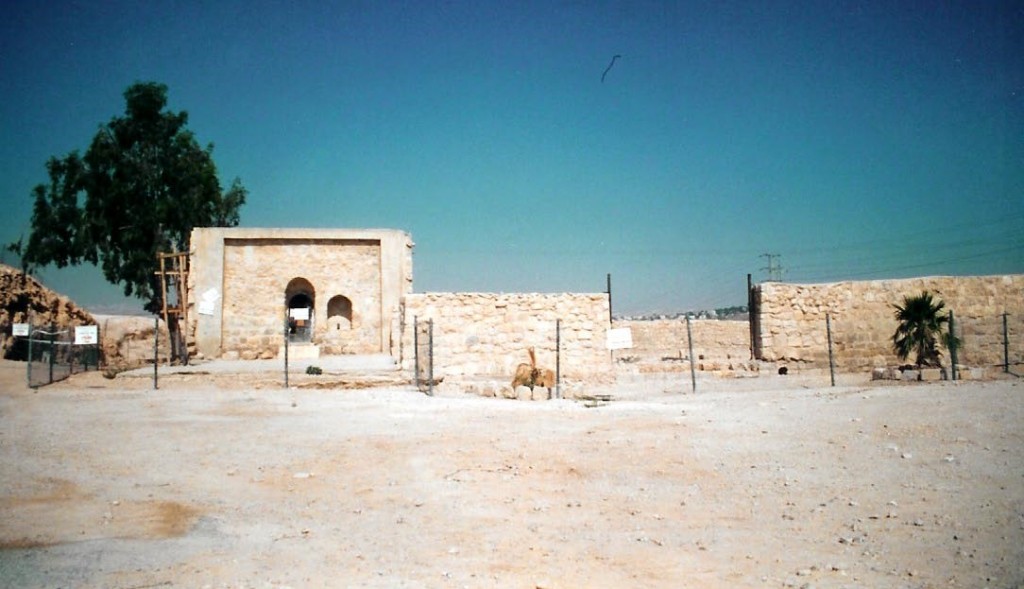
12.01.05.D. THE GOOD SAMARITAN INN. Legend said there once was an inn midway between Jericho and Jerusalem. That legend was based on a khan, or way station, that was built by the Sultan Ibrahim Pasha (1494-1536) of the Ottoman Empire for traveling camel caravans. Since such facilities were generally built upon the ruins of previous ones, the khan added credibility to the legend. However, the legend was not taken seriously until in the late 1990s when evidence was found of a Byzantine church that commemorated an ancient inn. Visitors today can see the evidence of the Byzantine church that commemorated the inn that once stood at this site, and was probably referred to by Jesus. Photographed by the author in 2003 when the archaeological site was under restoration.
The religious elite had two serious obligations or yokes under which they lived.
It is the second vow that was taken to an extreme and is demonstrated here. The exaggerated attitude of purity held by the priest can be seen in the Apocryphal book of Ben Sirach 1:1-7. Here lies the sentiment that undoubtedly saddened Jesus. The priests were instructed not to help those who were sinners, because supposedly, God hates sinners. The narrative is as follows:
If you do a kindness, know to whom you do it,
and you will be thanked for your good deeds.
Do good to a godly man, and you will be repaid –
if not by him, certainly by the Most High.
No good will come to the man who persists in evil
or to him who does not give alms.
Give to the godly man,
but do not help the sinner
Do good to the humble,
but do not give to the ungodly;
hold back his bread,
and do not give it to him
(lest by means of it he subdue you);
for you will receive twice as much evil
for all the good you do to him.
For the Most High also hates sinners
and will inflict punishment on the ungodly.
Give to the good man
but do not help the sinner
Ben Sirach 12:1-7[21]
“Pouring on oil and wine.” Olive oil had numerous uses in the ancient world. In this parable, it was used as a medical remedy for injuries. It was also used in religious services in the temple and for lamps in the home (Mt. 25:1-13). It was used as a condiment (Judges 9:9; Hosea 2:8), for baking (Num. 11:8), and even used after a bath (Ruth 3:3; 2 Sam. 12:20). In an anointing context, it was used to anoint the king upon his coronation (1 Sam. 10:1; 16:1, 13), priests (Lev. 8:30), prophets (Isa. 61:1), and for certain sacrifices (Lev.2:4). In the New Testament it was used by the elders of the church to anoint the sick. Wine has antiseptic qualities and they understood that it had beneficial effects on open wounds.
It should be noticed that the Good Samaritan performed his good deed without any pious phrases or self-congratulation on his own virtuous action. In Luke 10 there is no response given by the lawyer, because the reader is to place himself in that position and answer the question. Yet what the Good Samaritan did will not qualify for eternal life. In the Parable of the Sheep and Goats (Mt. 25:31-46) there are two groups of people standing before God on the day of the last judgment. One group repeatedly demonstrated mercy and kindness to those in need and the other group didn’t. What Jesus said is that true faith takes action in helping others.
Finally, it is unfortunate that for some seventeen or eighteen centuries this parable and many others were not been properly understood. The well-known and highly respected early church father, St. Augustine, was convinced this parable was an allegory with hidden meanings. Three examples of his allegorical interpretations are as follows:
Each character in the parable was given a name and function that had some type of spiritual application. But his interpretations are clearly not what Jesus had in mind.[22]
A Lesson in First Century Hermeneutics:
12.01.05.X Use Of Known Stories And Events
As Christian believers who are removed from the historical event by two thousand years, it is difficult to comprehend the cultural setting of various gospel narratives. Hence, the belief that since the words of Jesus are divinely inspired, every story and parable is an original idea with Him. In reality, Jesus used stories and concepts with which the people were already familiar. He spoke of fishing, bread, losing a coin, and many other events that His listeners had already experienced.
These are stories to which His listeners could relate. What is difficult, however, is for the modern student to comprehend what stories, fables and legends were common in the first century. His words were obviously inspired and original and were presented in a manner that His listeners, who had no books, television, radio, or recording devices, could remember. He not only used parables and poetic genre as a memory tool but also existing stories of history, common sayings, current events, and He adapted all of them to His message. Therefore, His parables were not quickly forgotten.
< ——————————————– >
[1]. Bailey, Poet and Peasant. Part I, 72 and Part II, 40; Fleming, The Parables of Jesus. 62.
[2]. Lightfoot, A Commentary on the New Testament from the Talmud and Hebraica. 3:9.
[3]. Josephus, Antiquities 20.6.1 (118); Wars 2.15.6 (232).
[4]. Gilbrant, “Luke.” 335; Jeremias, Jerusalem in the Time of Jesus. 336.
[5]. Josephus says that the Essenes, when traveling, carried nothing but swords because they feared the thieves. Wars 2.8.4; Wars 2.15.6 (232); Antiquities 20.6.1(118).
[6]. Jeremias, Jerusalem in the Time of Jesus. 59; Geikie, The Life and Works of Christ. 2:278; Farrar, The Life of Christ. 364.
[7]. Mishnah, Berakhoth 1.3; Mishnah, Shabbath 2.5
[8]. Josephus, Antiquities 20.6.1. The Samaritans, however, did not threaten the Jews when they left Jerusalem and traveled towards Galilee. It was a symbolic gesture stating that leaving Jerusalem, symbolic of Judaism, was good.
[9]. The ancient city of Jericho was destroyed, never to be rebuilt. A new city by the same name was built a short distance from the ancient ruins of the first.
[10]. Josephus, Antiquities 17.11.8.
[11]. Gilbrant, “Luke.” 335; Jeremias, Jerusalem in the Time of Jesus. 336.
[12]. Guignebert, The Jewish World in the Time of Jesus. 59-60.
[13]. Carter, 13 Crucial Questions. 57.
[14]. The Samaritans believed in a slightly modified version of the Mosaic Law. See 02.01.17 for the basics of their theological beliefs.
[15]. Vine, “Ability, Able.”Vine’s Complete Expository Dictionary. 2:2.
[16]. Vine, “Neighbor.”Vine’s Complete Expository Dictionary. 2:429-30.
[17]. Bailey, Jesus through Middle Eastern Eyes. 292.
[18]. Bowman, Jesus’ Teaching in its Environment. 31-32; Bailey, Jesus through Middle Eastern Eyes. 292-93.
[19]. Lee, The Galilean Jewishness of Jesus, 112.
[20]. Edersheim, The Life and Times of Jesus the Messiah. 216; Lee, The Galilean Jewishness of Jesus, 112.
[21]. Metzger, The Apocrypha of the Old Testament. 143.
[22]. Mowry, “Allegory.” 1:82-84.
12.01.06 Lk. 10:38-42
JESUS WITH MARTHA AND MARY
38 While they were traveling, He entered a village, and a woman named Martha welcomed Him into her home. 39 She had a sister named Mary, who also sat at the Lord’s feet and was listening to what He said. 40 But Martha was distracted by her many tasks, and she came up and asked, “Lord, don’t You care that my sister has left me to serve alone? So tell her to give me a hand.”
41 The Lord answered her, “Martha, Martha, you are worried and upset about many things, 42 but one thing is necessary. Mary has made the right choice, and it will not be taken away from her.”
Disciples and students always sat on the ground in respect for their teacher. In this case, it was Mary who “sat at the Lord’s feet” like a faithful disciple.[1] It was the cultural norm that rabbis stood when they read the Torah and sat when teaching. To sit at the teacher’s feet was ancient body language that said that the listener desired to be taught and would apply the instruction to his or her life. In this case, Martha was working hard to accommodate Jesus, while Mary, in Martha’s opinion, was just sitting there doing nothing. Jesus responds kindly by saying that the issues at hand were more important.
[1]. Lang, Know the Words of Jesus. 49.
12.01.07 Lk. 11:1-4
TEACHING HOW TO PRAY
1 He was praying in a certain place, and when He finished, one of His disciples said to Him, “Lord, teach us to pray, just as John also taught his disciples.”
2 He said to them, “Whenever you pray, say:
Father,
Your name be honored as holy.
Your kingdom come.
3 Give us each day our daily bread.
4 And forgive us our sins,
for we ourselves also forgive everyone
in debt to us.
And do not bring us into temptation.”
Judaism had developed a sophisticated series of prayer books, similar to many churches of later centuries. Modern critics often reflect upon the “deadness” of liturgical prayers, but fail to recognize that the Jews also prayed extemporaneously.[1] Messianic scholars insist that in biblical times the free and open flow of prayer was common and that included prayers in the temple. Jesus, being an orthodox Jew, would have prayed a number of liturgical prayers at their appropriate times as well as spontaneous prayers whenever needed.
For the disciples, ministry with Jesus was a profound adventure. They knew He communicated with God and since they observed the results of His prayers, the only request they ever made was, “Lord, teach us [how] to pray.” This prayer model is similar to the example given on the Mount of Beatitudes (Mt. 6:9-13), where the prayer is incorporated into the famous Sermon on the Mount. Matthew included six petitions whereas Luke mentioned only five. The point was to learn how to pray from the heart, not what to pray from a predetermined script.
The disciples obviously noticed that after He prayed, there were incredible results. They realized that the prayers of Jesus were answered – profoundly! In their simple understanding, they believed that if they learned how to pray like Jesus did, they would achieve similar results. A relationship with God is something they would learn later. Another point to consider is this: A unique difference between how Jews and Christians pray is the subject of their prayers. Christians will ask God to bless their food while Jewish people will bless God for their food that He has provided. Which is greater, the food or the God who provided the food? Maybe it is time for Christians to pray the Jewish way.
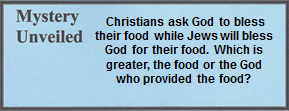
Finally, according to the book of Jubilees, the synagogue service was a long dry lecture of the smallest details of rabbinic rules and regulations.[2] In fact, the book of Jubilees is considered one of the most important authorities on Jewish customs and opinions at the time of Jesus, second only to the Mishnah.[3] It included everything about proper washing before and after eating, to the kind and quality of wood needed for the temple altar. By this time the disciples not only realized there was a refreshing and unique difference between the sermons of Jesus and those of the local rabbis, but there was a difference between their prayers. And the disciples wanted to know how to pray with results like Jesus had.
[1]. Schneider, “How Should We Pray?” 18.
[2]. See Philo, The Works of Philo. 689-90 quoted in 06.02.02.Q1. Also Martin, Worship in the Early Church. 24. Lightfoot, A Commentary on the New Testament from the Talmud and Hebraica. 3:67; Geikie, The Life and Works of Christ. 2:3-4.
[3]. Geikie, The Life and Words of Christ. 1:560.
12.01.08 Lk. 11:5-13
PARABLE OF A MIDNIGHT FRIEND
5 He also said to them: “Suppose one of you has a friend and goes to him at midnight
A and says to him, ‘Friend, lend me three loaves of bread,
B 6 because a friend of mine on a journey has come to me,
C and I don’t have anything to offer him.’”
C’ 7 Then he will answer from inside and say, ‘Don’t bother me!
B’ The door is already locked, and my children and I have gone to bed.
A’ I can’t get up and give you anything.’
8 I tell you,
“even though he won’t get up
and give him anything
because he is his friend,
yet because of the man’s boldness
he will get up
and give him as much as he needs.”
9 “So I say to you:
Keep asking, and it will be given to you.
Keep searching, and you will find.
Keep knocking, and the door will be opened to you.
10 For everyone who asks receives; he who searches finds,
and to him who knocks,
the door will be opened.’”
11 What father among you, if his son asks for a fish,
will give him a snake instead of a fish?
12 Or if he asks for an egg,
will give him a scorpion?
13 If you then,
who are evil,
know how to give good gifts
to your children,
how much more
will your heavenly Father
give the Holy Spirit
to those who ask him!”
The literary style of verses 5-7 is rather technical, as the patterns are not recognized with repeating words.[1] The reader needs to observe the motives behind each stanza, clearly reflecting the skill the first century listeners had in understanding and memorizing complicated parables. In line A, a request to give a loaf of bread is made, whereas in A’ the negative answer is given for the loaf of bread. In lines B and B,’ the reason is given with a final comment in C and C’.
The literary style changes in verses 8-13 and is relatively easy to follow with repeating words in the matching lines.[2] Undoubtedly, some may find this to be somewhat difficult at first, which is why this writer has added several letters followed by an explanation. However, the listeners of the first century were trained to listen in this manner and immediately recognized the patterns.
“Goes to him at midnight and says.” At midnight people were sound asleep and a knock on the door was very unusual. With hearing only a knock, the residents would not know who was outside – and that would be a frightening event. But when the unexpected visitor speaks, those inside will recognize his voice. Interestingly, in this culture strangers knocked, but neighbors and friends called. The fact that someone both knocked and called reveals an urgent situation.
The moral of the story is that if an unwilling friend is willing to serve at midnight, how much more is our Father in heaven ready to supply our needs? The lesson Jesus gave is that God the Father desires to give His children good gifts, just as any earthly father would do for his children. Likewise, just as a fish and eggs are good food, snakes and scorpions are hazardous.[3]
[1]. Bailey, Poet and Peasant. Part I, 120.
[2]. Bailey, Poet and Peasant. Part I 48, 120, 135; Fleming, The Parables of Jesus. 71.
[3]. For a similar theme and literary style, see 08.04.05; Mt. 7:7-12.